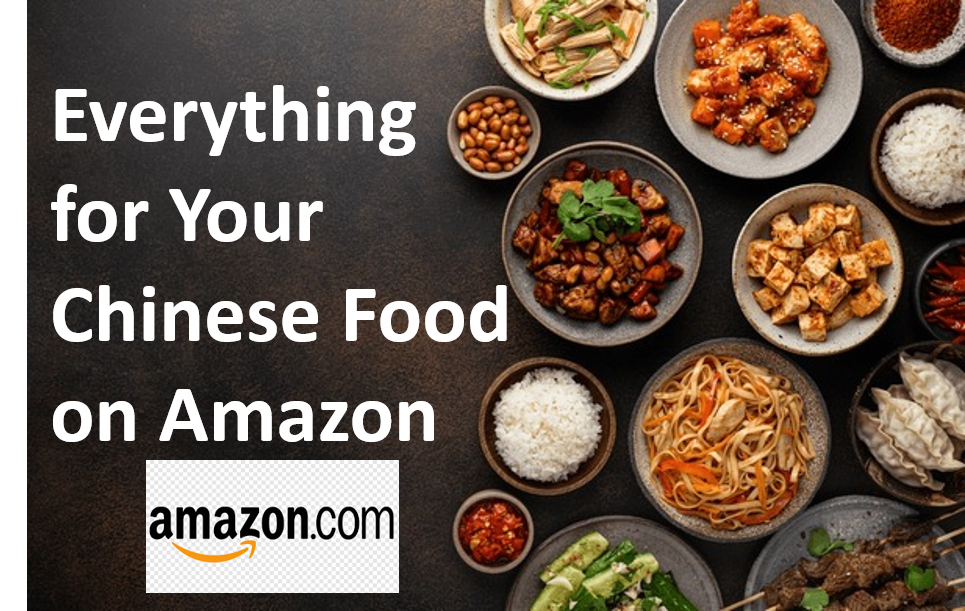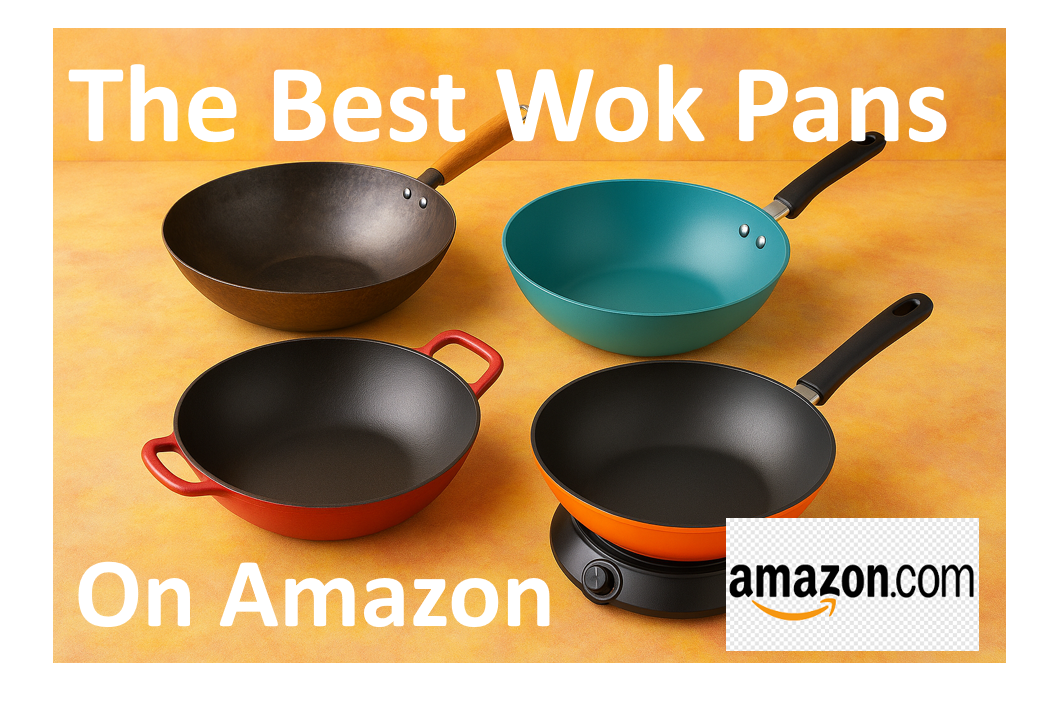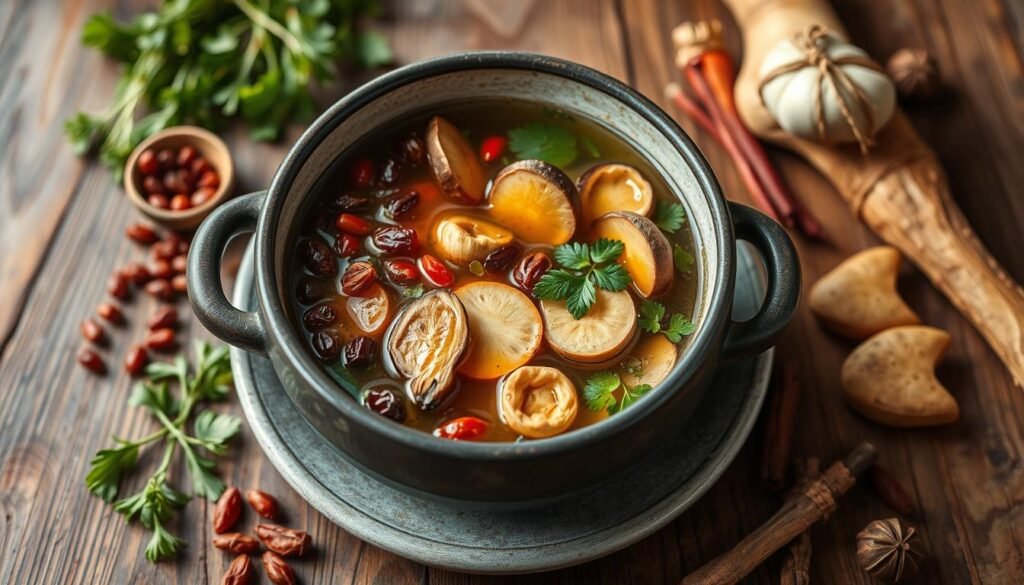
Welcome to the world of Chinese herbal soup. This tradition has been around for centuries, nourishing both body and soul. You’re about to learn how to make authentic Chinese herbal soup, a key part of traditional Chinese medicine.
Exploring homemade soup, you’ll discover the special medicinal herbs used in these dishes. You’ll learn about their history and how to make them. This guide will help you every step of the way, so you can make your own delicious Chinese herbal soup.
This guide gives you a detailed recipe and a table of ingredients. It’s perfect for health enthusiasts, foodies, or anyone looking to try new recipes. You’ll learn about the benefits of traditional Chinese medicine and how to use it in your daily life with Chinese herbal soup.
Understanding the Ancient Tradition of Chinese Herbal Soup
Exploring chinese herbal soup takes you back to ancient times. Traditional Chinese Medicine has been around for thousands of years. It focuses on balance and harmony in the body and with nature.
This approach to healing emphasizes living in harmony with the environment. It uses medicinal herbs to restore balance and promote well-being.
Chinese herbal soup has been used for generations to heal. Each recipe is made to tackle specific health issues. By adding medicinal herbs to your meals, you can benefit from traditional Chinese Medicine. This helps you understand the connection between body, mind, and spirit.
Some key principles of traditional Chinese Medicine include:
- Balance and harmony: The goal is to restore balance and harmony within the body and with nature.
- Holistic approach: It considers the whole person – body, mind, and spirit – when addressing health concerns.
- Natural healing: Medicinal herbs and other natural substances are used to promote healing and well-being.
By embracing traditional Chinese Medicine and adding chinese herbal soup to your life, you can experience natural healing.
Essential Ingredients for Your Herbal Soup
Preparing Chinese herbal soup requires top-notch ingredients. You’ll use a variety of herbal ingredients with special healing properties. Ginseng, astragalus, licorice root, and ginger are key. They form the base of traditional Chinese herbal medicine.
First, you need to know how much of each ingredient to use. Here’s a list of the must-haves and their usual amounts:
- 2-3 slices of ginger
- 1-2 tablespoons of dried astragalus
- 1-2 tablespoons of dried licorice root
- 1-2 tablespoons of ginseng
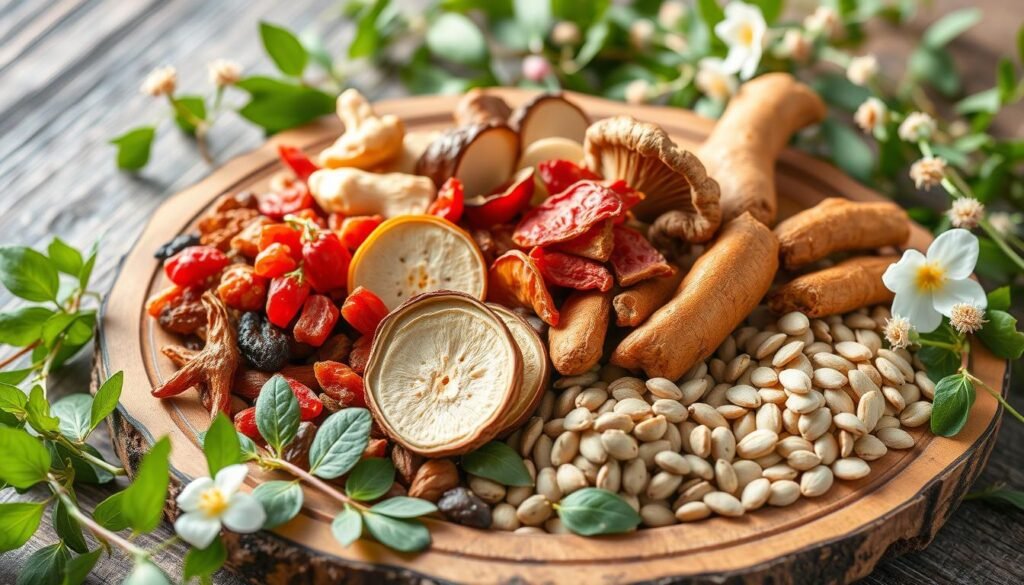
These herbal ingredients are the heart of traditional Chinese herbal soup. Knowing their healing properties is crucial. By mixing them correctly, you make soups that are not only delicious but also good for your health.
The Health Benefits of Traditional Chinese Herbal Soup
Exploring Chinese herbal soups reveals many health benefits. These soups support your immune system, improve digestion, and boost energy. Adding them to your diet can enhance your well-being naturally.
Chinese herbs offer a wide range of health benefits. Some herbs boost your immune system, while others aid digestion. Others increase energy and vitality, making them great for daily use.
Key Health Benefits
- Immune system support: Certain herbs can help strengthen your immune system, reducing the risk of illness and infection.
- Digestive health: Chinese herbal soups can help soothe digestive issues, such as bloating and cramps, and promote healthy digestion.
- Energy and vitality: Some herbs can help increase energy levels, reducing fatigue and improving overall well-being.
Understanding the health benefits of Chinese herbs lets you take care of your health. Whether you want to boost your immune system, improve digestion, or increase energy, Chinese herbal soups are a natural solution.
With the right herbs and knowledge, you can make tasty, healthy soups. Try Chinese herbal soups and see the benefits for yourself.
Common Types of Chinese Medicinal Herbs Used in Soups
Exploring chinese medicinal herbs opens up a world of ingredients for soups. You’ll find everything from root herbs to dried flowers and mushrooms. Each herb has its own benefits, helping you make soups that meet your health needs.
Root herbs like ginseng and burdock are favorites. They nourish and balance the body. These herbs make soups that are tasty and good for you.
Properties of Root Herbs
Root herbs are known for strengthening the body. They also calm the mind and promote relaxation. Other herbs, like dried flowers and mushrooms, bring extra benefits. Dried flowers soothe, while mushrooms boost the immune system.
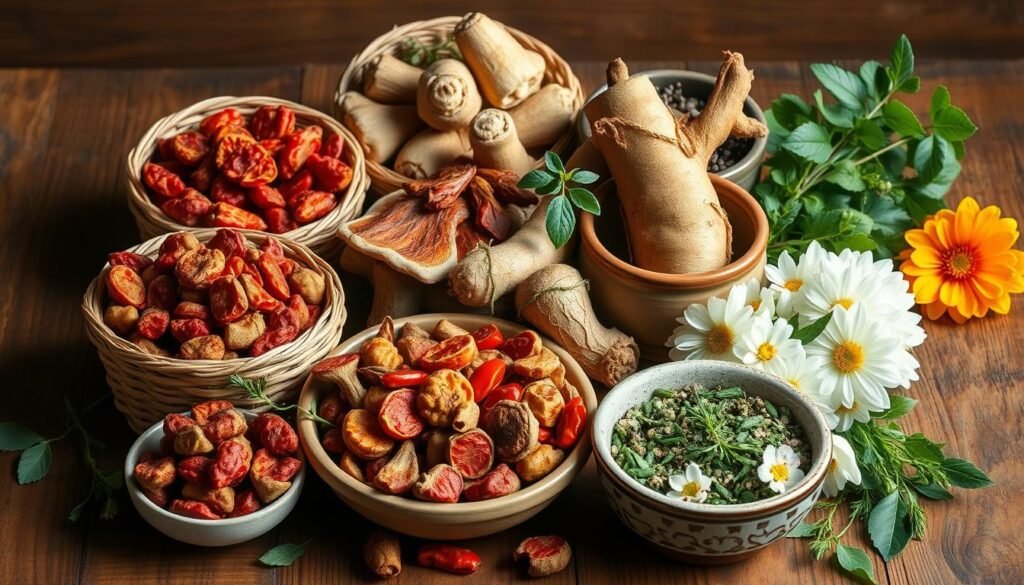
Dried Flowers and Fruits
Dried flowers and fruits are also key in chinese soups. They add flavor, texture, and nutrition. Popular choices include:
- Rose petals
- Chrysanthemum
- Dried citrus peel
- Goji berries
Mushrooms and Fungal Ingredients
Mushrooms and fungi are used in traditional soups too. They support the immune system and improve digestion. Some favorites are:
- Reishi mushrooms
- Shiitake mushrooms
- Cordyceps
- Turkey tail mushrooms
Adding these herbs to your soups makes them both tasty and healthy. They support your health and well-being.
Selecting and Storing Your Herbal Ingredients
Choosing the right herbal ingredients is key to a great Chinese herbal soup. Selecting herbal ingredients means picking the freshest and highest-quality herbs. Look for herbs that smell good and are free of contaminants.
After picking your herbs, storing herbs right is important. Keep them in a cool, dry spot, away from sunlight and moisture. Use airtight containers to keep their herbal quality in check.
Here are some tips for selecting and storing herbal ingredients:
- Choose herbs that are certified organic and sustainably sourced
- Store herbs in a cool, dry place, such as a pantry or cupboard
- Keep herbs away from direct sunlight and moisture
- Use airtight containers to preserve the herbal quality
By following these tips, your herbal ingredients will stay fresh and potent. This will make your Chinese herbal soup more effective and tasty.
Basic Equipment Needed for Perfect Herbal Soups
Preparing Chinese herbal soups requires the right cooking equipment. From clay pots to slow cookers, the choice affects flavor and texture. You also need essential tools and utensils for an easier cooking process.
In today’s kitchens, modern cooking utensils like silicone spoons and stainless steel strainers are popular. They are easy to clean and last long. You’ll also need a mortar and pestle, a fine-mesh sieve, and measuring cups and spoons for precise measurements.
Here are some key pieces of equipment you’ll need to get started:
- Cooking vessel (traditional clay pot or modern slow cooker)
- Silicone spoon and stainless steel strainer
- Mortar and pestle
- Fine-mesh sieve
- Measuring cups and spoons
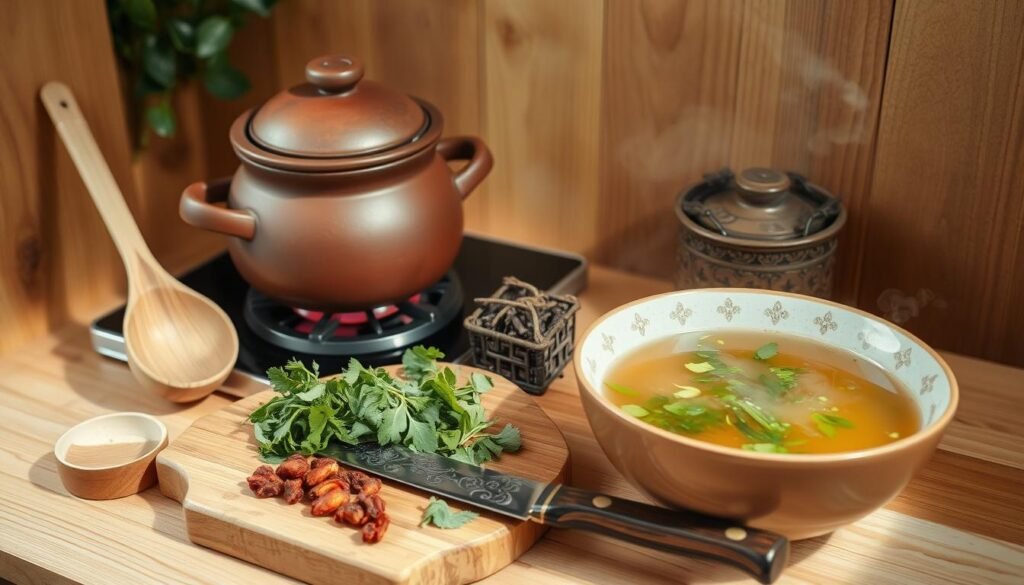
Investing in the right cooking equipment and traditional cooking vessels makes creating delicious Chinese herbal soups easy. Modern cooking utensils help streamline your cooking, saving you time in the kitchen.
| Equipment | Description |
|---|---|
| Cooking Vessel | Traditional clay pot or modern slow cooker |
| Silicone Spoon and Strainer | Essential tools for cooking and straining |
| Mortar and Pestle | For grinding herbs and spices |
Step-by-Step Guide to Making Chinese Herbal Soup
To start making chinese herbal soup, you need to prepare your ingredients and equipment. You’ll need chinese herbs like ginseng and astragalus. Also, a pot and utensils for cooking.
A herbal soup recipe mixes herbs and ingredients. They are simmered together to make a nourishing and tasty soup. Here’s a basic recipe to start with:
- Gather your ingredients, including chinese herbs, chicken or other protein, and vegetables.
- Prepare your equipment, including a pot and utensils for cooking.
- Combine the ingredients in the pot and add water or broth.
- Bring the mixture to a boil, then reduce the heat and simmer for 30 minutes to an hour.
Following this step-by-step guide, you’ll learn the basics of making chinese herbal soup. You’ll be able to make your own delicious and nutritious herbal soup recipe.
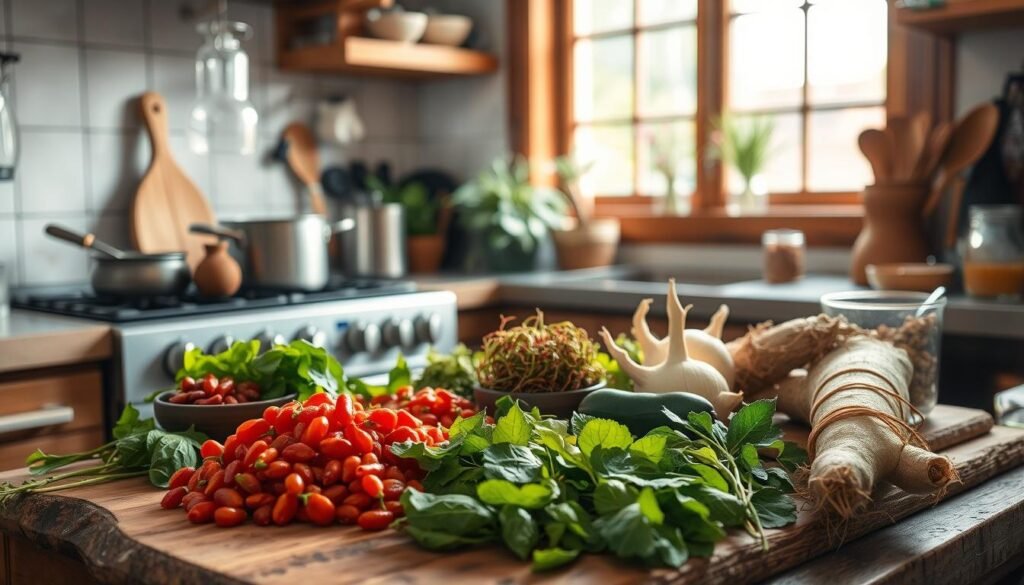
Combining Herbs: Understanding Complementary Ingredients
Making great Chinese herbal soups is an art. It’s about picking the right herbs together. This way, you get a soup that tastes good and helps your health. To learn more, check out Chinese herbal medicine websites.
Choosing the right herbs to mix is key. This is where seasonal combinations play a big role. Picking herbs that match the season makes your soup fresh and healthy. For example, in winter, use ginger and cinnamon to fight off colds.
Seasonal Combinations
- Winter: Combine warming herbs like ginger and cinnamon to boost your immune system.
- Spring: Use cooling herbs like peppermint and chamomile to help with detoxification.
- Summer: Combine herbs like lemongrass and mint to help with digestion and relaxation.
- Autumn: Use herbs like turmeric and ginger to help with inflammation and immune system support.
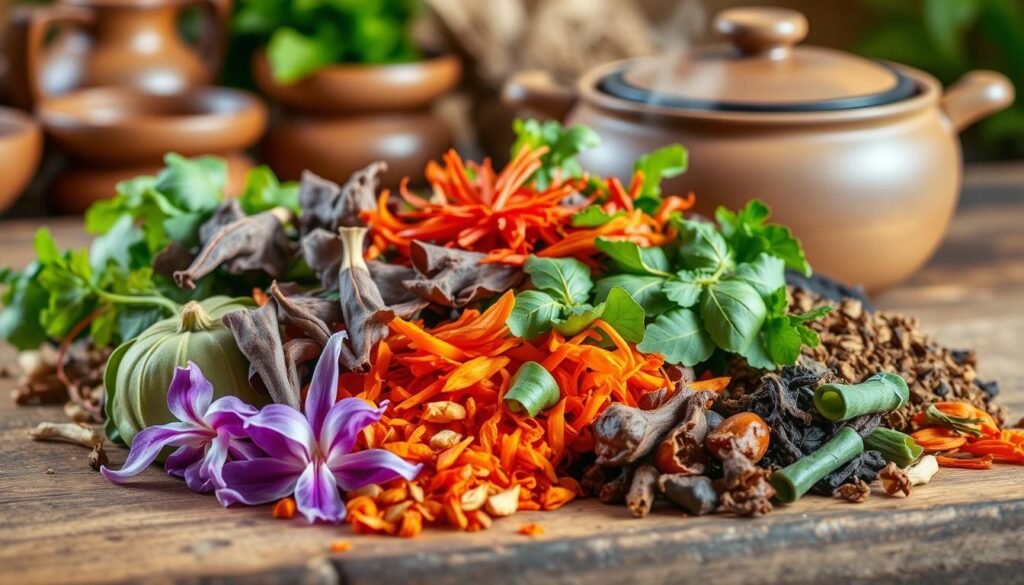
Health-Specific Blends
You can also make blends for specific health needs. For more energy, mix ginseng and ashwagandha. For better digestion, try peppermint and licorice root.
Common Mistakes to Avoid When Making Herbal Soups
When making Chinese herbal soups, common mistakes can happen. Even with great ingredients and tools, errors can occur. Knowing these mistakes helps make your soups delicious and effective.
Start by learning the basics of Chinese herbal soup making. Use the right ingredients, like those in Chinese chicken herbal soup. Also, follow the right cooking methods. Some common mistakes include:
- Not using fresh, high-quality ingredients
- Not adjusting ingredient ratios according to personal preferences
- Not cooking the soup for the recommended amount of time
By avoiding these herbal soup mistakes, you can make tasty and effective Chinese herbal soups. For more tips and recipes, check out jugosnaturales.net.
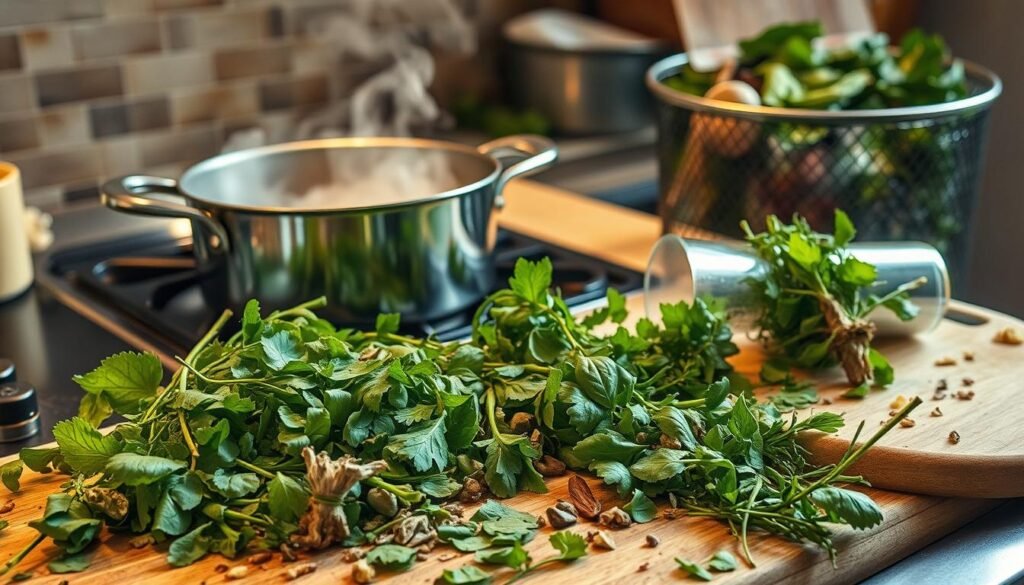
Adapting Traditional Recipes for Modern Kitchens
Exploring Chinese herbal soups can be exciting, but traditional recipes might take too long. Luckily, there are time-saving techniques to make these soups quick and easy in your modern kitchens. You can swap out hard-to-find ingredients for easier ones, fitting these recipes into your busy life.
For instance, check out websites with recipes and tips on tweaking traditional Chinese herbal soup recipes. This way, you can whip up tasty, healthy soups that are ideal for your modern kitchens.
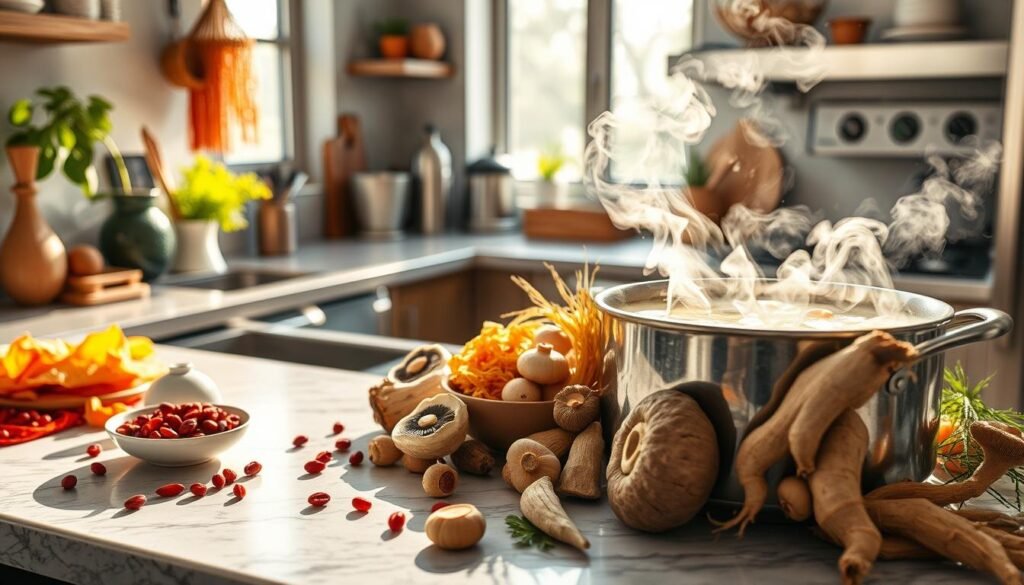
- Prepping ingredients in advance
- Using a slow cooker to simmer the soup
- Substituting ingredients with more readily available alternatives
By using these methods, you can enjoy Chinese herbal soups without losing too much time. A bit of creativity and trying new things can help you adapt traditional recipes to your modern lifestyle. This way, you can enjoy the health benefits of these soups right in your own modern kitchens.
| Technique | Description |
|---|---|
| Prepping ingredients | Chop and prepare ingredients in advance to save time during cooking |
| Using a slow cooker | Simmer the soup in a slow cooker to reduce cooking time and effort |
| Substituting ingredients | Replace hard-to-find ingredients with more readily available alternatives |
Conclusion: Embracing the Healing Power of Chinese Herbal Soups
As you finish exploring Chinese herbal soups, remember they’re more than food. They’re a tradition based on traditional Chinese medicine. By enjoying these Chinese herbal soups, you nourish your body and follow a holistic wellness path.
If you’re new to traditional medicine or already a fan, the Chinese herbal soup world is open to you. It offers warmth, complexity, and great benefits. Let these soups be part of your self-care, giving you nourishment and healing.
Wellness is a journey, not a race. Enjoy each sip, try new flavors, and let the soups heal you. As you grow to love Chinese herbal soups, you’ll connect with a rich cultural heritage and timeless wisdom.

